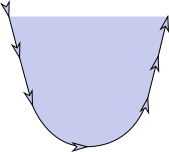Thicker picks, in and of themselves, do not produce a darker sound. What happens is that thicker picks allow for a more rounded shape which releases a string smoothly, which has the effect of exciting fewer harmonics.
You can sharpen a thick pick, which will produce a brighter sound.
Thin picks cannot be made dull. That is to say, they cannot be made more dull than their thickness allows.
We can draw a diagram of the side profile (viewed flat) of the tip of pick like this:
The arrows indicate a path from the front of the pick, across the tip and to the back surface. This path has to reverse 180 degrees, more or less, regardless of the size of the pick. The narrower the pick, the tighter the space in which that 180 degree reversal takes place, regardless of the specific shape of the tip.
We can draw an analogy here to pencils. A mechanical pencil with 0.5 lead cannot produce a line more dull than 0.5 mm. An artist's pencil with a thick lead can produce a much thicker line. It doesn't have to, though; it can be sharpened.
A thicker pick can have a similar profile to a thin one at the very tip. In the following image, the "U" at the very bottom is almost identical to that in the previous image:
With this profile, we can get a similar tone to the thin pick (all else being equal: material and surface finish), but with far less flexibility.
But at that thickness, the pick can also be shaped like this:
This low curvature allows the thick pick to produce an attack with low harmonic content, and this curvature is off limits to the thin pick. Thus you will not hear thin picks making that sort of attack, unless they are used on an angle to mimic the low curvature.
If we try a less curved profile on the thin pick, we will create sharp edges which will catch the string and re-introduce the high harmonics that we are trying to mute:
Actually sharpening a thick pick to a cusp will produce a bright edge in the tone with a sharp attack:
In addition to shape, texture is important. A rough texture excites the harmonics in a string, similarly to the way a violin bow does. A smooth pick that glides noiselessly across the string excites fewer harmonics.
By controlling the texture, material and contour of a thick pick (say 1.5 mm), a wide tonal range is possible.
Why is the shape related to tone? Basically when we move the pick across the string, the string follows the contour of the pick, and so the contour of the pick is translated to signal: the way the shape of the groove in a vinyl record moves a needle to reproduce a signal. A signal with sharp features has more high frequency content.





